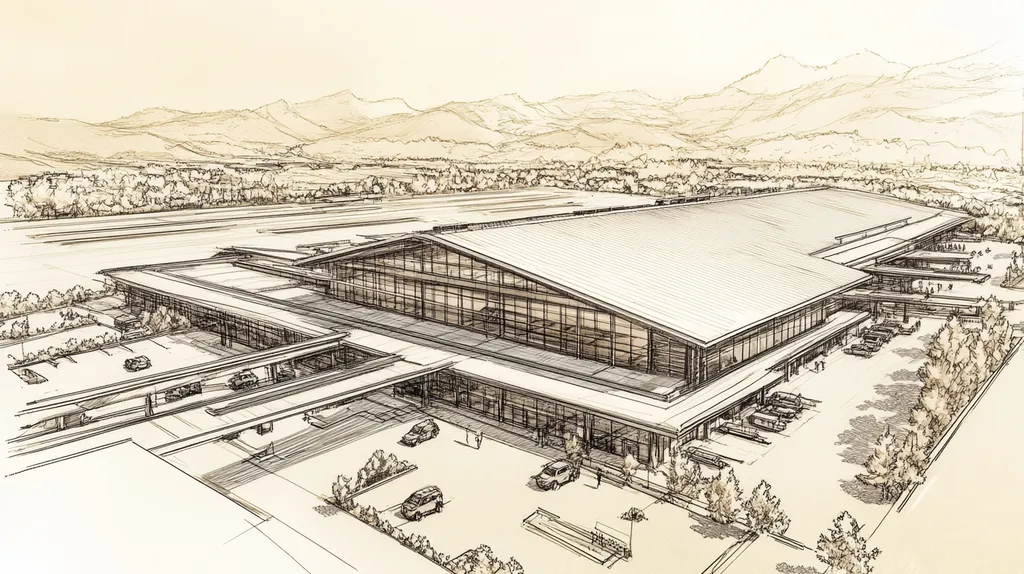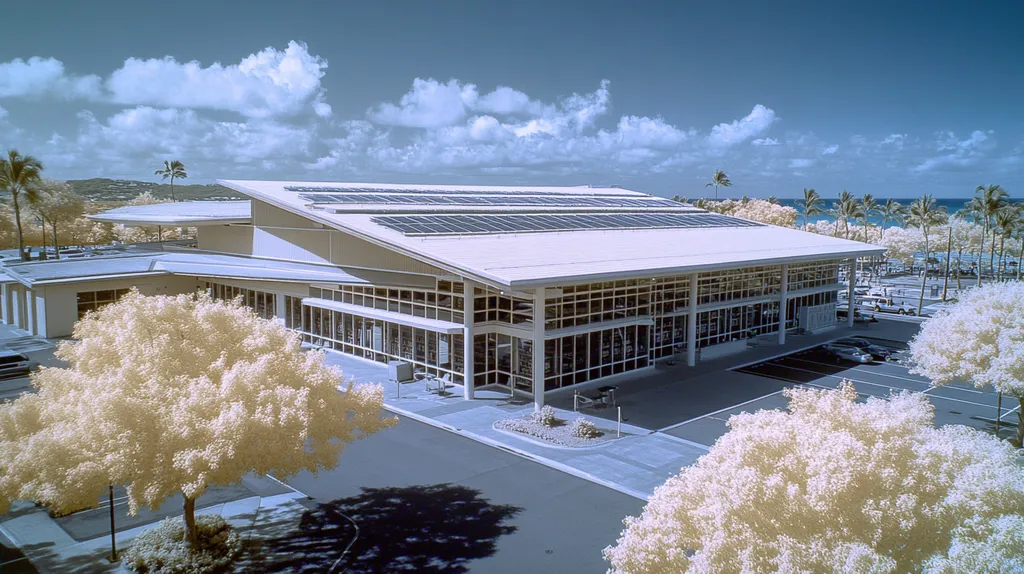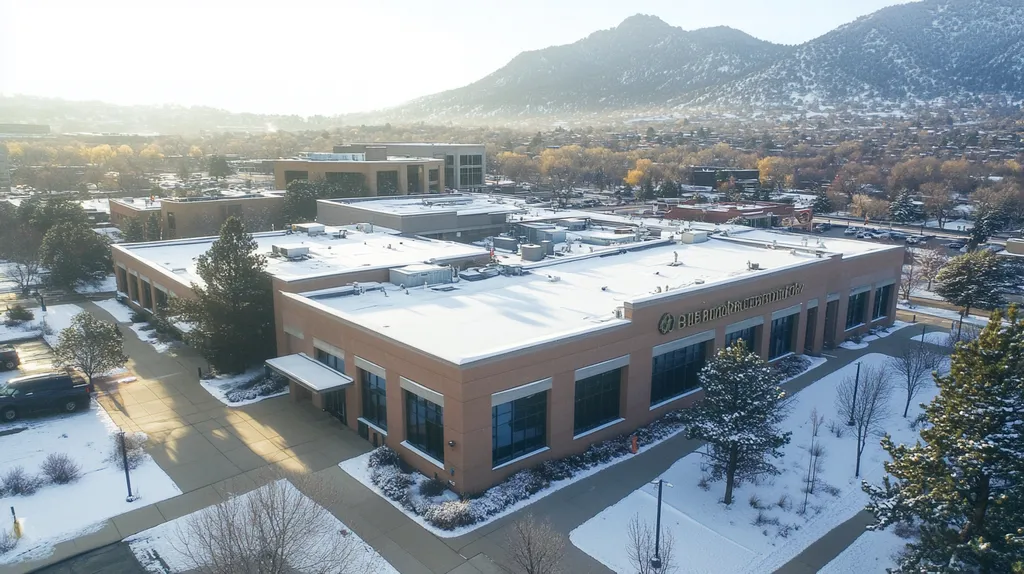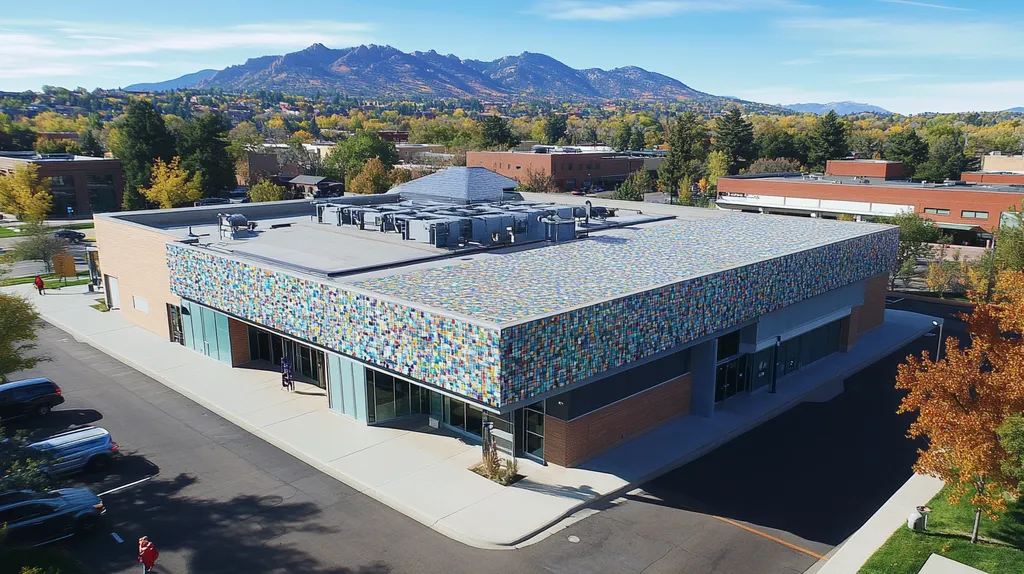Commercial roofing failures cost businesses over $2.5 billion annually, with 40% of these expenses directly linked to mismatched materials for local climate conditions.
As extreme weather events increase in frequency and severity, selecting climate-appropriate roofing materials has become critical for protecting commercial investments and ensuring building longevity.
This comprehensive guide examines the essential factors in matching roofing materials to specific climate challenges, from thermal dynamics and moisture control to implementation methods and performance metrics.
SECTION 1: FUNDAMENTAL CONCEPTS
Every year, commercial property owners lose millions of dollars due to premature roof failures caused by mismatched materials and climate conditions. Research shows that up to 40% of all commercial roof replacements occur before the end of their expected lifespan, primarily due to poor material selection for local weather patterns. Understanding the relationship between roofing materials and climate factors is crucial for protecting your investment and avoiding costly failures. This section examines the critical elements that influence roofing performance across different environments.
Climate Zones and Their Roofing Challenges
Each climate zone presents distinct challenges that directly impact roofing system performance. Hot-humid zones face constant moisture exposure and UV degradation, while cold regions battle freeze-thaw cycles and ice dam formation.
Temperature swings pose a particular threat to roofing integrity. Daily thermal cycling can cause materials to expand and contract repeatedly, leading to membrane fatigue and eventual failure if incorrect materials are specified.
Coastal areas require specialized consideration due to salt spray exposure and intense storm patterns. These environments demand corrosion-resistant materials and enhanced attachment methods to prevent wind uplift damage.
Urban environments create unique microclimate challenges, with heat island effects raising roof temperatures up to 50°F higher than surrounding areas. This demands materials with superior heat resistance and reflective properties.
Thermal Dynamics Affecting Roof Materials
Understanding thermal dynamics is essential for proper material selection. Heat flow through roofing assemblies can account for up to 25% of a building’s total energy loss when materials are improperly specified.
Different roofing materials exhibit varying thermal properties. Dark surfaces can absorb up to 95% of solar radiation, while highly reflective materials may reflect over 80% of heat energy.
Thermal mass characteristics significantly impact building performance. Materials with high thermal mass can help regulate interior temperatures by absorbing excess heat during peak hours and releasing it during cooler periods.
The interaction between insulation and roofing materials creates a complex thermal system. Proper material combinations can reduce HVAC loads by up to 30% compared to poorly specified systems.
Moisture and Wind Impact on Roof Durability
Moisture penetration represents the single greatest threat to roof longevity. Even minor leaks can compromise structural integrity and lead to extensive damage if left unchecked.
Wind forces create complex pressure patterns across roof surfaces. Negative pressure zones at roof edges and corners can generate uplift forces exceeding 100 pounds per square foot during severe weather events.
The combination of wind and rain presents particularly challenging conditions. Wind-driven rain can force moisture into the smallest openings, requiring careful attention to seam design and flashing details.
Material degradation accelerates when moisture becomes trapped within roofing assemblies. Proper ventilation and drainage design are essential for preventing premature aging and maintaining long-term performance.
SECTION 2: SYSTEM COMPONENTS
Commercial roofing represents a critical investment where component selection can mean the difference between decades of protection and premature failure. Studies show that 85% of roofing failures stem from poor material choices that don’t match local climate conditions. With commercial buildings accounting for nearly $30 billion in annual roofing expenditures, choosing the right system components becomes crucial for protecting both the structure and bottom line.
Selection of Membranes and Insulation Materials
Modern roofing membranes must balance durability with climate-specific performance requirements. Single-ply membranes like TPO and EPDM offer distinct advantages in different environments, with TPO excelling in hot climates and EPDM providing superior flexibility in colder regions.
Insulation selection directly impacts both energy efficiency and membrane longevity. Polyisocyanurate provides the highest R-value per inch, while expanded polystyrene offers excellent moisture resistance for humid climates.
The interaction between membrane and insulation layers creates a dynamic system. Proper material pairing can reduce thermal stress on membranes by up to 40% while improving building energy efficiency.
Climate-specific membrane thickness and attachment methods play crucial roles in system performance. Thicker membranes provide better puncture resistance, while appropriate attachment systems prevent wind uplift damage.
Structural Supports for Climate Adaptation
Structural support systems must account for both dead loads and climate-specific live loads. Enhanced deck strength becomes crucial in regions with heavy snow accumulation or frequent maintenance traffic.
Proper slope design and drainage patterns prevent water pooling that can compromise structural integrity. Even minimal standing water can add significant weight stress to roofing supports.
Support spacing and fastener patterns must adapt to local wind conditions. High-wind zones require closer fastener spacing and enhanced perimeter reinforcement to maintain system integrity.
Temperature fluctuations necessitate appropriate expansion joints and control measures. Strategic placement of these components prevents structural damage from thermal movement.
Roofing Coatings and Reflective Surfaces
Advanced coating technologies offer significant protection against UV degradation and thermal stress. Cool roof coatings can reduce surface temperatures by up to 60°F, extending membrane life and reducing cooling costs.
Surface reflectivity directly impacts building energy consumption. High-reflectance coatings can reduce peak cooling demands by 15-25% in commercial buildings.
Coating selection must consider local environmental conditions. Areas with high rainfall require enhanced water resistance, while regions with severe temperature swings need coatings with superior flexibility.
Regular recoating schedules maintain system performance and extend service life. Proper coating maintenance can double the effective lifespan of many roofing systems while maintaining energy efficiency benefits.
SECTION 3: IMPLEMENTATION METHODS
The difference between a long-lasting commercial roof and premature failure often comes down to implementation quality. Industry data shows that improper installation causes up to 47% of all roof failures within the first five years. Even premium materials will underperform without proper installation techniques, fastening systems, and integrated solutions for ventilation and drainage. Understanding and executing these critical implementation methods can double roof lifespan while maximizing energy efficiency.
Installation Techniques for Thermal Efficiency
Single-ply membrane installation requires precise attention to detail for optimal thermal performance. TPO roofing systems, when properly installed, deliver superior energy efficiency through their highly reflective surface and excellent UV resistance, with typical lifespans of 15-20 years. (source: Kerrigan Roofing)
Membrane seam welding temperatures must be carefully controlled to ensure watertight bonds. Hot-air welding equipment should maintain consistent temperature and pressure across the entire seam length to prevent weak points that could compromise system integrity.
Proper insulation installation creates a continuous thermal barrier that maximizes energy savings. Staggered joints between insulation boards prevent thermal bridging, while appropriate adhesive coverage ensures long-term attachment.
Quality control measures during installation should include frequent seam probing and pull tests. These verification steps help identify potential weak points before they become problematic.
Fastening Systems for Wind and Load Resistance
Enhanced fastening patterns at roof perimeters and corners provide critical wind uplift resistance. These high-stress zones require up to three times more fasteners than field areas to prevent membrane separation during severe weather.
Mechanical fastener selection must account for deck type and anticipated loads. Steel decks typically require heavy-duty screws with stress plates, while concrete decks may need specialized anchors for secure attachment.
Proper fastener spacing prevents membrane billowing and reduces stress on seams. Field testing during installation ensures fastener pullout values meet or exceed design requirements.
Regular inspection of fastening systems helps identify potential failure points early. Special attention should focus on areas where different materials meet, as these transition points often experience the greatest stress.
Integrating Ventilation and Drainage Solutions
Strategic placement of roof drains and scuppers ensures efficient water removal. Drain locations should account for deck deflection and potential ponding areas to prevent water accumulation.
Ventilation systems must balance air intake and exhaust to prevent moisture buildup. Proper calculation of net free ventilation area ensures adequate airflow through the roofing assembly.
Integration of cricket systems directs water flow away from roof penetrations and equipment. These raised areas prevent water from collecting behind obstacles that could lead to premature membrane failure.
Regular maintenance of drainage paths prevents system blockage and overflow. Inspection schedules should increase during fall and spring when debris accumulation typically peaks.
SECTION 4: MAINTENANCE REQUIREMENTS
Proactive maintenance is the cornerstone of commercial roof longevity, yet studies show that 80% of roofs are maintained reactively, leading to premature failure. A well-executed maintenance program can extend roof life by 5-10 years while reducing annual repair costs by up to 50%. Climate-specific challenges demand tailored maintenance approaches to protect this critical building asset and prevent catastrophic failures.
Routine Inspection Protocols by Climate Type
Metal roofing systems require specialized inspection protocols focused on corrosion points and joint integrity. In coastal environments, inspections should occur quarterly to catch early signs of salt-air degradation and prevent structural compromise.
Single-ply membrane systems demand careful examination of seam integrity and surface condition. TPO and EPDM roofs need particular attention to areas around penetrations and corners where stress concentrations can lead to failure.
Hot climates necessitate bi-annual inspections focusing on UV damage and thermal stress patterns. Surface chalking, membrane shrinkage, and adhesive degradation require prompt attention to prevent system failure.
Cold regions demand fall and spring inspections to verify drainage paths and identify potential ice dam formation points. Careful documentation of inspection findings helps track degradation patterns and optimize maintenance timing.
Managing Snow, Ice, and Moisture Accumulation
Metal roofing, TPO, EPDM, PVC, and modified bitumen systems each provide excellent resistance against severe weather conditions including heavy rain, hail, and high winds. However, proper maintenance remains critical for preserving these protective qualities. (source: Nations Roof)
Snow load management requires careful attention to structural design limits. Establishing clear removal protocols prevents damage from excessive weight while protecting roof surfaces from mechanical damage during clearing operations.
Ice dam prevention focuses on maintaining proper insulation and ventilation performance. Regular inspection of heat cables and drainage systems ensures proper operation during critical freeze-thaw cycles.
Moisture mapping helps identify potential problem areas before visible damage occurs. Infrared scanning can detect trapped moisture within roofing assemblies, allowing for targeted repairs before extensive damage develops.
Repair Strategies for Material-Specific Wear
Single-ply membrane repairs require careful surface preparation and compatible materials. Small punctures and tears should receive immediate attention to prevent moisture infiltration and insulation damage.
Metal roof repairs focus on maintaining weathertight seams and preventing galvanic corrosion. Proper fastener replacement and coating renewal preserve system integrity and prevent rust formation.
Built-up roofing repairs demand careful attention to maintaining proper drainage slopes. Addressing blisters and separations promptly prevents moisture intrusion and maintains system performance.
Modified bitumen systems require regular assessment of surface coatings and seam integrity. Proper repair techniques maintain the watertight integrity of the membrane while preserving its flexibility and durability.
SECTION 5: PERFORMANCE METRICS
Accurate performance metrics form the foundation of successful commercial roofing investments. Studies show that improper material selection based on incomplete performance data leads to 35% higher lifecycle costs and premature system failure. Understanding and tracking key metrics across thermal efficiency, material durability, and structural integrity helps facility managers make data-driven decisions that protect their investment while optimizing building performance.
Measuring Thermal Resistance and Energy Efficiency
For hot, dry climates, clay tiles, metal roofing, and light-colored materials offer superior thermal performance through enhanced solar reflectance and natural ventilation properties. Metal roofing systems provide exceptional heat reflection while maintaining structural integrity in extreme temperatures. (source: Cobex CG)
R-value measurements provide standardized thermal resistance comparisons across different systems. Higher R-values indicate better insulation performance, with properly specified systems reducing heating and cooling costs by up to 40%.
Solar reflectance index (SRI) ratings quantify a material’s ability to reject solar heat gain. Materials with high SRI values can reduce peak roof surface temperatures by up to 50°F compared to traditional dark surfaces.
Thermal emittance testing measures how effectively materials release absorbed heat. Enhanced emittance properties prevent heat buildup that can degrade roofing components and stress HVAC systems.
Evaluating Material Longevity and Weather Resilience
Accelerated weathering tests simulate decades of exposure to determine material durability. UV resistance, thermal cycling, and chemical exposure metrics help predict actual service life under specific climate conditions.
Impact resistance ratings indicate a material’s ability to withstand hail and falling debris. Higher ratings correlate directly with reduced maintenance costs and extended service life.
Wind uplift resistance testing measures system performance under dynamic pressure loads. Enhanced attachment methods and material selection can increase wind resistance by up to 50% compared to minimum code requirements.
Flexibility and dimensional stability metrics predict how materials will perform through thermal cycles. Materials maintaining flexibility across wide temperature ranges show significantly lower failure rates.
Assessing Water Tightness and Structural Integrity
Hydrostatic pressure testing verifies seam integrity and system water resistance. Modern testing methods can detect even microscopic leaks that could compromise long-term performance.
Pull-through and tear resistance measurements evaluate material strength at attachment points. Enhanced mechanical properties reduce the risk of system failure during severe weather events.
Puncture resistance testing simulates maintenance traffic and impact loads. Materials with superior puncture resistance show 60% fewer maintenance-related failures.
Load deflection analysis ensures structural compatibility between roofing components. Proper material selection prevents stress concentration that can lead to premature system failure.
SECTION 6: OPTIMIZATION STRATEGIES
Commercial roofing optimization has become a critical business imperative, with studies showing poorly optimized systems can increase operating costs by 40% while reducing property values. Recent industry data reveals that 65% of commercial buildings operate with sub-optimal roofing configurations, leading to excessive energy waste and accelerated deterioration. Strategic optimization through enhanced materials, climate-specific upgrades, and data-driven maintenance can dramatically improve building performance while protecting valuable assets.
Enhancing Roof Reflectivity and Insulation
TPO roofing systems deliver exceptional energy efficiency in hot climates through their highly reflective surface and superior UV resistance, while PVC roofing offers outstanding heat resistance and durability with lifespans reaching 30 years. Both materials provide significant air conditioning savings through enhanced thermal performance. (source: Kerrigan Roofing)
Advanced insulation systems create thermal barriers that reduce energy transfer by up to 35%. Proper installation and material selection ensure consistent performance across varying climate conditions.
Strategic placement of reflective coatings can reduce peak roof temperatures by 50-75°F. This dramatic reduction in heat absorption extends material lifespan while decreasing cooling costs.
Regular monitoring of thermal performance helps identify areas needing enhanced protection. Infrared scanning can detect insulation gaps and thermal bridges that compromise system efficiency.
Climate-Specific Material Upgrades and Retrofits
Material upgrades must address specific environmental challenges to maximize effectiveness. High-wind zones require enhanced attachment systems, while areas with frequent thermal cycling need materials with superior flexibility.
Retrofit solutions can dramatically improve existing roof performance without full replacement. Strategic overlays and coating systems extend service life while enhancing climate resistance.
Moisture management upgrades prevent condensation damage in humid environments. Vapor barriers and ventilation improvements protect insulation value and prevent premature deterioration.
Enhanced drainage systems prevent water accumulation that can compromise material integrity. Proper slope modification and drain placement ensure effective water removal under all conditions.
Predictive Maintenance Using Performance Data
Data-driven maintenance strategies reduce repair costs by 35% while extending service life. Regular collection of performance metrics enables early problem detection and targeted interventions.
Thermal imaging and moisture scanning create detailed performance maps. These tools identify developing issues before visible damage occurs, allowing for preventive repairs.
Automated monitoring systems track key performance indicators continuously. Real-time data alerts facility managers to conditions requiring immediate attention.
Historical performance data guides strategic upgrade planning. Analysis of repair patterns and system behavior enables optimal timing of major improvements.
The Bottom Line
Commercial roofing failures cost businesses over $2.5 billion annually, with nearly half directly attributable to improper material selection for local climate conditions.
As climate patterns become more extreme, choosing appropriate roofing materials has never been more critical for protecting commercial investments.
The key to success lies in matching specific materials to local environmental challenges while implementing proper installation techniques and maintenance protocols.
By leveraging advanced materials, climate-specific design strategies, and data-driven maintenance approaches, facility managers can extend roof lifespans by up to 40% while reducing annual operating costs by 25-30%.
The future of commercial roofing depends on this systematic, climate-focused approach to material selection and system optimization.
FREQUENTLY ASKED QUESTIONS
Q. What are the best materials for commercial roofs in different climates?
A. Selecting materials tailored to your climate is vital for longevity. Hot and humid areas typically benefit from materials like TPO, while cold climates might prefer EPDM. Coastal regions need corrosion-resistant options to withstand salt exposure.
Q. How do I choose the right insulation for my industrial roof?
A. Consider R-value and moisture resistance when selecting insulation. Polyisocyanurate offers excellent thermal performance, while expanded polystyrene is great for humid conditions. Proper pairing with your roofing membrane ensures maximum energy efficiency and longevity.
Q. What installation methods are best for my commercial roof?
A. Proper installation techniques are crucial for roof performance. Focus on accurate seam welding for membranes and precise insulation placement to create thermal barriers. Regular quality checks during installation can help identify weaknesses before they become problems.
Q. How often should I inspect my commercial roof?
A. Inspections should be routine and tailored to your climate. In coastal areas, quarterly inspections help catch salt exposure early, while areas with snow require fall and spring checks for ice and water drainage issues.
Q. What metrics should I track for my commercial roof’s performance?
A. Focus on thermal resistance, weather resilience, and water tightness. Monitoring R-values and solar reflectance can help manage energy efficiency, while checking for puncture resistance ensures the roof can withstand physical stress.
Q. How can I optimize my commercial roofing system?
A. Implementing reflective coatings and enhancing insulation can significantly improve performance. Regular data reviews will help identify inefficiencies, while upgrades to climate-specific materials can enhance durability and reduce energy costs.
Q. What is the impact of climate on industrial roofing materials?
A. Climate affects roof durability and energy efficiency. High temperatures demand reflective materials, while cold climates need flexible options to handle freezing and thawing. Understanding these factors helps in selecting the right materials for longevity.










